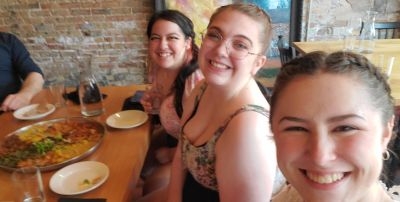When Ethnicity Gets Soggy
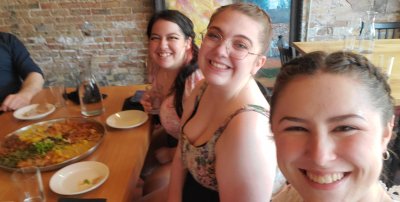
(From left to right) Hey I’m Irish Cortez! I’m a second year theater major – I’m April Pollock, and I’m a third-year music major -And I’m Lydia Stauffer, a second year history major!
Today was our first full day in Chicago! We started the day with a mini workshop about the layout of the city, how to navigate it, and how to understand where we were at any point in Chicago. We left the Center with Frita from our hosts at the Chicago Center for Urban Life, who helped guide us to our first stop, Heartland Alliance.
Heartland Alliance was founded by social reformer Jane Adams in 1888 primarily focused on travel and immigration assistance, and over the years has expanded into the wide reaching organization it is today. Part of our visit was about the Unaccompanied Children Program that Heartland runs. We learned about how children often come to the U.S. to reunite with family members already here, but are detained, and get sent into programs like this one. These programs house them, provide them with anything they may need (such as finding someone who speaks a rare language to be a translator).
We were also impressed to hear how the organization takes a harm reduction approach to care in its housing assistance program; there are no restrictions on what participants can or cannot do, including those struggling with addiction, but a focus on safety and wellness. A heavy emphasis on trauma-informed care means that incidents that could affect participants’ aid in federal programs will not affect the care and assistance they receive through Heartland Alliance.
After a heavy but very interesting and informative morning, we headed across the street to Demera, an Ethiopian restaurant. I (Lydia) am familiar with and love Ethiopian food already, so I was super excited for this part of our day. But most of our group, including Irish and April, had never eaten it before!
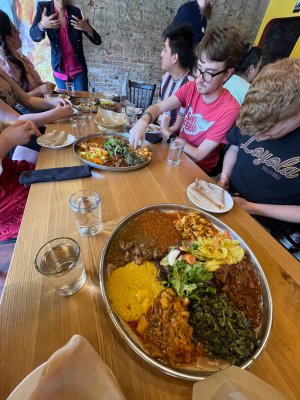
As someone who has never had Ethiopian, I (Irish) was excited and ready to try something new. Those who had had it before, talked very highly of it, so I was looking forward to it. I wasn’t sure what to expect, but my expeditions were exceeded! After a semester of Wendy’s, Taco Bell, and food from the Rott, this was a really great change in pace. We were offered various meats, ingredients, vegetables, spice levels, and textures all served on a few communal platters. We ate straight from the platters with our fingers using injera, a kind of sourdough flatbread with a similar shape and texture to a crepe, and your hands instead of silverware. There is significance in everyone picking up food from the same plate – it emphasizes a sense of community not often seen in American cuisine.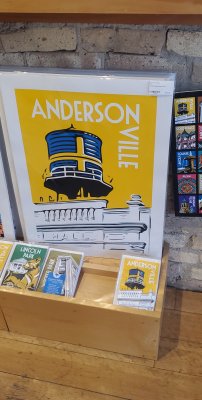
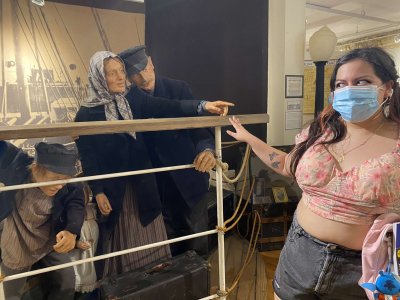
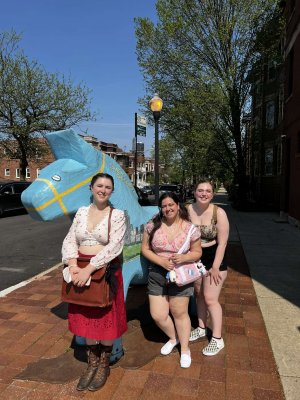
After Demera, our lovely guide Frita left us and Philipp took us on a “quick” walk to Andersonville, a historic Swedish neighborhood. We visited the Swedish-American history museum and learned about this history of immigration. The museum told the dual story of clinging to cultural heritage yet adapting to and making a positive impact on the Chicago area. We noticed how Swedish immigrants arriving in Chicago used events such as Midsommer as a way to celebrate their Swedish heritage, while engaging their non-Swedish neighbors. Swedish immigrants brought valuable skills from their home country and expanded upon them, enabling them and those around them to flourish.
After the museum we walked around Clark St. looking for traces of the Swedish history and commodification of ethnic Identity, as well as evidence of the changing times and recent mixing of cultures, or “ethnicity getting soggy” – essentially a blending, or perhaps watering down of distinctive cultural identity in exchange for a more homogenous white “American” identity. We explored a few shops and got to see some Swedish flag themed items, but also lots of things from other cultures, or not emphasizing any culture at all. Many of the traces of Sweden we found seemed to be commodified for our benefit as outsiders, rather than traditional items produced by Swedes for Swedes.
Some of our favorite things were a water tower that is no longer in use but has the Swedish flag painted on the side and is left standing as a reminder of the cultural heritage, and the giant, typically Swedish, wooden Dala horses that dotted the area.
After Andersonville, we used our newly acquired public transport skills to explore Chinatown before heading back to our house!
-Irish, Lydia, April






